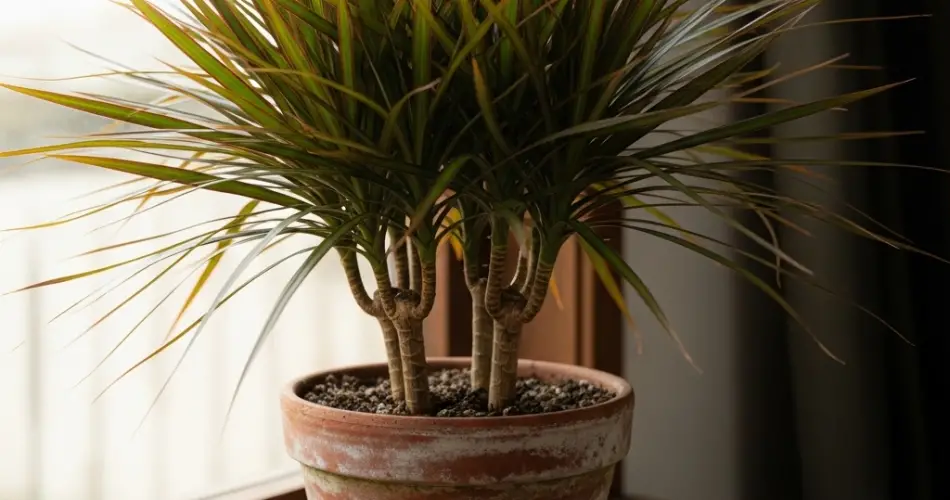Dracaena plants are well-loved for their sword-shaped leaves, architectural form, and ability to adapt to a wide range of indoor conditions. However, to get the best out of your Dracaena—whether it’s a marginata, fragrans, or compacta—it’s important to pair the plant’s light requirements with the right container. While soil, watering, and humidity all matter, the pot you choose plays a subtle but crucial role in regulating how light affects your Dracaena’s roots and growth habit.
This article guides you through how different container types, colors, and materials interact with light and how to choose the best container for your Dracaena’s growing environment.
Understanding Dracaena’s Light Preferences
Dracaena varieties typically thrive in bright, indirect light but can also tolerate low-light conditions. In high light, they grow faster and develop more vibrant foliage. In dimmer corners, growth slows, and leaf colors may fade.
This flexibility makes Dracaena perfect for indoor use—but also means that the pot needs to support the plant in its specific lighting environment. For instance, a dark pot in low light can hold too much moisture, while a light-colored container in direct sun can reflect excess light onto the roots. Selecting the correct container helps keep temperature, moisture, and light in harmony.
Light and Pot Color: What You Need to Know
The color of a container affects how much light and heat it absorbs or reflects.
-
Dark-colored pots (black, navy, dark green) absorb more heat and light. These are better suited for cooler or low-light rooms, where extra warmth helps stimulate root activity.
-
Light-colored pots (white, beige, pastel) reflect light and heat. These are ideal for bright spots or windowsills to prevent overheating and root stress.
-
Metallic or reflective pots can bounce light around the base of the plant and are best used as outer decorative cachepots with an inner nursery pot.
For example, if your Dracaena sits in a sunny room, a white or stone-colored pot helps regulate root temperature. If it’s in a shaded hallway, a dark-toned pot might provide a small warmth boost during colder months.
Pot Material Matters for Light and Moisture Balance
The material of your pot also influences how light and heat interact with the plant.
-
Ceramic pots: Glazed ceramic reflects light, helping regulate temperature. They’re great for bright spaces. Choose pots with drainage holes and use a saucer to catch excess water.
-
Terracotta pots: These clay containers are porous and absorb both moisture and light. They’re ideal in sunny areas because they help wick away excess moisture and keep roots cooler.
-
Plastic pots: Lightweight and often opaque, plastic retains moisture well. They’re suitable for lower-light conditions, but avoid dark plastic in full sun—it can cause the root zone to overheat.
-
Fiberglass or resin pots: Lightweight and often decorative, they perform well in moderate light and come in various finishes to suit your decor and lighting.
Matching Pot Size to Lighting Conditions
Dracaena’s root growth slows in low-light areas. If you place your plant in a dim hallway or office, a smaller pot helps prevent overwatering and root rot. Larger pots retain more moisture, which can be problematic when light is minimal.
In contrast, when Dracaena is grown near bright windows or under grow lights, it tends to grow faster and may need a slightly larger pot to accommodate the expanding root system.
As a general rule:
-
Low light: Use compact containers with good drainage.
-
Medium to bright light: Use standard-sized pots with room for roots to grow.
-
Bright indirect sun: Consider using lighter-colored, breathable containers to avoid overheating.
Elevate or Shield Based on Light Intensity
For Dracaenas placed in intense light, use pot stands or risers to keep the plant elevated and reduce heat absorption from hot surfaces like windowsills or tiled floors. In low-light rooms, choose stands with reflective bases or bright finishes to subtly increase light exposure.
In very sunny areas, consider adding a fabric wrap or cachepot around the nursery container to shade the roots. Alternatively, rotate the pot every week to ensure even light exposure and prevent leaning.
Drainage and Light Exposure
Regardless of pot color or material, ensure your container has proper drainage. In both high and low light, water must not accumulate at the bottom of the pot. Dracaena is sensitive to soggy conditions and prefers evenly moist—but not saturated—soil.
For indoor growers using plastic inner pots, place them in decorative containers that match the room’s light and temperature. This double-pot method allows easy removal during watering and gives you the freedom to style for both form and function.
Final Thoughts
When growing Dracaena indoors, don’t overlook the role of the container in relation to light. The right pot enhances not just your plant’s aesthetic presence but also its health and adaptability. Factor in light levels, pot material, color, and size when selecting a home for your Dracaena.
With the right container in the right location, you can enjoy healthy, vibrant Dracaena foliage year-round, whether it’s brightening your office, living room, or hallway corner.



